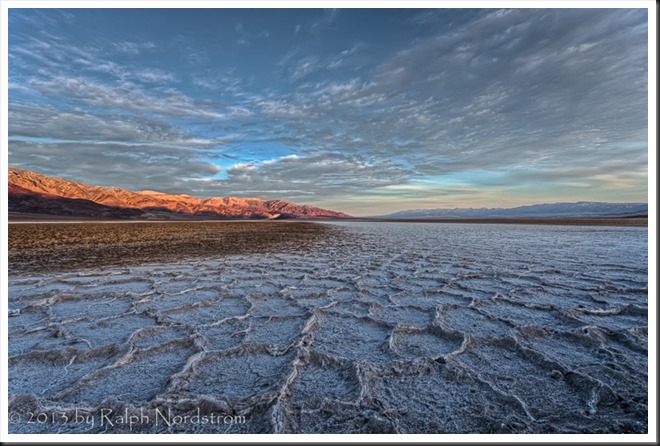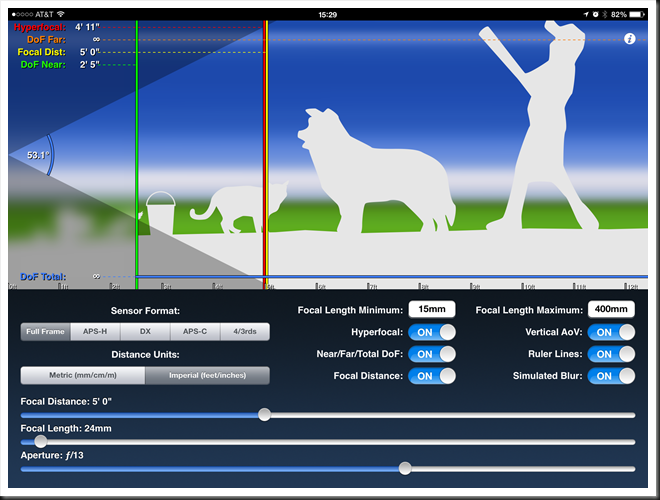A topic that receives a lot of attention in our workshops is focus. It’s incredibly important, so important that I consider Appropriate Sharpness to be one of the four pillars of a successful landscape photograph. (For more, read Making a Photograph – The Four Pillars.) Most of the questions center around depth of field and hyperfocal distance. In fact, this is so important that I give a class on Appropriate Sharpness during just about every workshop. Let’s start the discussion with Depth of Field
Depth of Field
This is the range, if you will, of objects in the view of your camera that are in focus. Objects in front of this range are out of focus as well as objects behind the range. A deep depth of field would have the flowers just a few feet from you camera and the distant mounts miles away all in focus. The depth of field would then extend from a couple of feet to infinity and for all practical purposes would be infinitely deep. This is often referred to as a ‘near-far composition.’
 A shallow depth of field may be just a couple of inches deep with nearer and more distant objects out of focus. This is referred to as ‘Selective Focus.’
A shallow depth of field may be just a couple of inches deep with nearer and more distant objects out of focus. This is referred to as ‘Selective Focus.’
Where to Focus, aka Focal Distance
Focusing may seem simple with sophisticated auto-focus cameras and lenses but one of the greatest challenges faced by landscape photographers is getting sharp images. To do that you need to answer two questions – where do I focus and how do I get the proper depth of field? Regarding determining where to focus, there are two techniques when you want everything to be sharp – focus on an object 1/3rd up from the bottom of the frame or focus on an object at the hyperfocal distance. Both of these techniques are useful in different situations,
The 1/3rd-up technique is most useful in photographs that do not include objects close to the camera. In general, if the nearest object is, say, at least 50 feet from the front of the lens then the 1/3-up technique works just fine. Sometimes auto-focus will give this to you; that is, it will select an object roughly 1/3rd up from the bottom of the screen. Other times it doesn’t. In that case, switch to manual focus, identify the object you want to use and use live view to focus on it. As for f/stop you can probably use f/8 or possibly f/11. (I should point out that we are talking about wide angle lenses here, NOT telephoto. They have a very shallow depth of field when focusing on nearby objects.)
The other technique is Hyperfocal Distance. But what is that? It’s the distance from the camera where, when you focus on it, everything is in focus from the nearest object to infinity.
The hyperfocal distance technique is indispensable when the nearest object is less than 20 feet from the front of the lens. And if the object is 10 feet or closer it’s the only way. The first step when using the hyperfocal technique is to compose your image. Adjust you zoom, tilt and turn your camera until you get the composition you want. Take your time and get it right. Next, observe an object at the bottom of the frame that is the closest to the camera lens. Then step to the side of your camera (you’re on a tripod, aren’t you?) and determine the distance from the lens to the object. You can guesstimate it, use a tape measure or a laser range finder, whatever. I guesstimate. Once you have this distance it’s easy to calculate the hyperfocal distance. You multiply it by two. Yep, that simple. One would think with a technical name like ‘hyperfocal distance’ that you’d have to have a degree in algebra but fortunately for all of us we only need to remember our 2 times tables.
So let’s do a quick example. Say when you get your image composed the nearest object is 2.5 feet from the front of the lens and the most distant object is at infinity. This is going to require an extreme depth of field (we’ll get to that in a moment). But it’s easy to figure the hyperfocal distance – it’s 5 feet.
Getting the Proper Depth of Field
The techniques we’re discussing assume you have setup your camera to give you the proper depth of field. But how do you adjust the depth of field? Well, without changing your focal length or the object you’re focusing on (your focal distance) you adjust your aperture. Lower f/stops give a shallower depth of field and higher f/stops give a deeper depth of field. The next question then is what f/stop do you need? Well, there’s an app for that – lots of them actually. Oh yea, I almost forgot. You can print depth of field charts off the internet. But why use paper charts when you can use a cool app.
I like Lens*Lab. It’s available for both iOS and Android and it looks like this…
I was a little put off by this at first thinking the display is a bit cluttered with a lot of confusing controls. But after playing with it a little it’s become my favorite. A Depth of Field app should be able to easily answer the question, “What f/stop will give me the proper depth of field?” And this one does it the best. But first, let me show you around.
At the top is a pictorial representation of what is in focus and what is out with some numbers in the upper left hand corner that quantify that. The green line shows the beginning of the depth of field range and the orange line shows the end. The yellow line shows your focal distance. At the very bottom are three sliders to adjust the three variables that determine the depth of field – Focal Distance, Focal Length and Aperture. In the middle is where you configure Lens*Lab for your particular camera and lenses. For example, my camera has a full frame sensor so that is what I selected.
Continuing with the example above, the nearest object is 2.5 feet from the camera and we know we want to focus on our hyperfocal distance which is 5 feet. So we set the Focal Distance slider to 5’ 0”. Assume we’re using a 24-70 mm f/2.8 zoom lens zoomed all the way out to 24 mm. The Focal Length slider is set to 24 mm. At this setting our depth of field, as revealed by the figures on top, extends from 4’ 1” to 6’ 4”. In other words, our total depth of field is only 2’ 3”. That’s because the f/stop is wide open and our focal distance is only 5 feet away. Back to the question, what f/stop do we need to get the depth of field we want? To determine that we start sliding the Aperture slider to the right. As we do all of the lines start moving except our yellow focal distance line. The orange line leaves the frame on the right as our depth of field increases and a red line moves in to take it’s place. That’s the Hyperfocal Distance line.
The farther we move the slider to the right the farther the red Hyperfocal Distance line moves to the left. Now, based on our composition (which we haven’t changed) we know the hyperfocal distance we want is 5’ which is where we set the Focal Distance slider. So if we continue moving the Aperture slider to the right eventually the red Hyperfocal Distance line will reach our yellow Focal Distance line and that will tell us the f/stop we need to get a depth of field that will extend from our nearest object at 2’ 6” to infinity. Let’s do that and see what we get.
The two lines coincide at f/13 and that’s what we need to set our aperture at. If we take a peek at the statistics in the upper left corner we see that the Hyperfocal Distance is 4’ 11”, the DoF Far is infinity, the Focal Distance is still 5’ 0” and the DoF Near is 2’ 5”. So at f/13 everything will be in focus from 2.5 feet to infinity. We make the adjustment on our camera without disturbing anything else and now we can press the shutter.
I always have my iPhone with me on shoots so that I can run this quick calculation when the 1/3rd-up technique doesn’t apply. And this technique really works. Another good thing is it forces you to slow down which I think is so important to connecting with your subject. And it saves the extreme frustration of getting home and finding out that an image you were really excited about is ruined because it’s out of focus.
Now, I know someone who reads this will say, “What about diffraction?” or “You’re forgetting about circles of confusion and pixel size.” And, yes, these are valid points. But this article is long enough and that will be a good topic for a follow-up article.
(3440)





One thought on “Mastering Sharpness – Depth of Field”